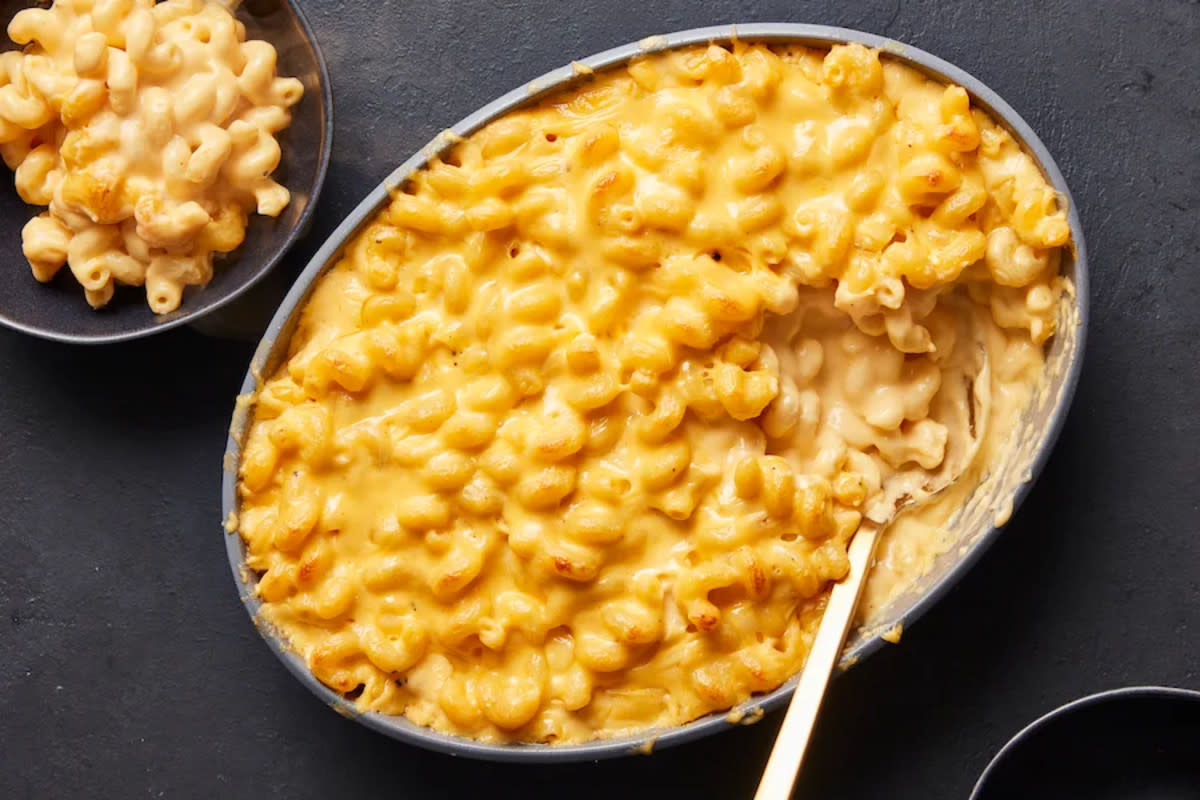Eric Kim's Copycat Stouffer's Macaroni and Cheese Recipe Will Change Your Life

New York Times food writer Eric Kim may have just broke the code on a classic: Stouffer's Macaroni and Cheese. Kim grew up eating the Stouffer’s version on Thanksgiving and recreated the ultimate dupe with his Copycat Stouffer's Macaroni and Cheese recipe. "It’s got the best of all worlds," raves Kim. "It's creamy, saucy comfort, with a consistency that’s slightly more set than a stovetop version, thanks to a final bake in the oven. The key to the texture is Velveeta, which prevents the sauce from separating in the oven."
Keep reading for Kim's tricks, tips and cheesy go-to ingredients for one epic Thanksgiving side dish.
Related: The Best Thanksgiving Appetizer Ideas
What's your inspiration for this Stouffer's-inspired creamy baked macaroni and cheese?
This recipe is inspired by Stouffer’s macaroni and cheese and delivers the best of all worlds: creamy, saucy, comfort, with a consistency that’s slightly more set than a stovetop version, thanks to a final bake in the oven. It stays voluptuous and molten as a result of a higher ratio of sauce to noodles, which are cooked completely so they don’t soak up as much liquid.
Why do you love to reinterpret classic dishes from childhood?
For me, it does come from an emotional and personal place. I grew up eating Stouffer’s mac and cheese and it was always my idea of what a mac and cheese should be: heftier than a stovetop mac and more voluptuous than a classic Southern baked mac (which is also so, so delicious and very important to many people, but I didn’t grow up with that). I think what makes a Stouffer's mac and cheese special from a regular stovetop or baked mac and cheese is that it exists somewhere between the two. It’s creamy, but it’s also a little set with those baked edges, which you can take as far as you like. You get the best of both worlds I think.
What's the secret to copycat Stouffer's mac and cheese creaminess?
The biggest lesson I learned has to be how to get that perfect cheese sauce texture, almost like nacho cheese. I have to give some credit to my food stylist friend Jesse Szewczyk. I was testing the recipe and had baked off maybe 10 pans of macaroni and cheese that day and was going a little crazy, and the cheese kept separating. The texture was grainy and watery, or the noodles had soaked up all the moisture, which tends to happen with many baked macaroni and cheeses that don’t have stabilizing agents in them. Jesse told me that food stylists use sodium citrate to stabilize mixtures like that, so the key to keeping this sauce creamy, gooey and together is Velveeta, which has sodium citrate in it. But I’d like to think I gave options: If you’re one of those people who hates Velveeta, whether the flavor of it or what it represents (that’s for another conversation), I’d say go out and buy sodium citrate and experiment. It’s your mac and cheese. I’m just the messenger.
What's the best pasta to use for Stouffer's Mac and Cheese?
Elbow macaroni works fine, but cavatappi is an especially fun shape to eat with its telephone-cord bounciness.
What are the best cheeses for the ultimate mac and cheese?
The ideal cheeses for the ultimate mac and cheese are the cheeses that taste good to you. Personally and ordinarily, I would go for one young cheddar, one old cheddar, and a Pecorino Romano or Gruyere—something with great flavor. You really don’t need more than two or three cheeses, but mixing them is great because each cheese offers something different. You could think of it as building out your preferred flavor profile. But if it’s a baked macaroni and cheese, I would use mostly young cheeses, especially a yellow cheddar, and a little Velveeta for its sodium citrate.
Best Stouffer's Mac and Cheese Recipe (Video):
Next up: Best Thanksgiving Charcuterie Board Ideas
Stouffer's Mac and Cheese Recipe (Copycat)
Ingredients
Salt
1 lb cavatappi or elbow macaroni
½ cup unsalted butter
½ cup all-purpose flour
6 cups whole milk
1 lb sharp or extra-sharp yellow Cheddar, coarsely grated (5¼ cups)
8 oz Velveeta, torn into pieces
4 oz Pecorino Romano, coarsely grated (1 cup)
½ tsp dry mustard powder
¼ tsp onion powder
Pinch of ground cayenne
Freshly ground black pepper
Heat oven to 350 degrees.
Bring a large pot of water to a boil and season generously with salt. Add the pasta and cook according to package instructions, stirring occasionally with a wooden spoon, until just past al dente. Drain and set aside.
Return the empty pot to the stove (no need to clean it) and set over medium heat. Melt the butter and simmer, whisking occasionally, until the butter stops spurting and quiets down, 2 to 3 minutes. Add the flour and cook, whisking, until smooth like gravy, about 1 minute.
Whisk in the milk. Raise the heat to high and bring to a simmer, whisking constantly, then immediately reduce the heat to low and continue simmering until the sauce lightly coats the back of a spoon, 2 to 5 minutes. At this stage, the sauce should be smooth but relatively loose. Take the pot off the heat.
To the pot, add the cheddar, Velveeta, Pecorino Romano, mustard powder, onion powder and cayenne, and season generously with salt and black pepper. Whisk until the cheese is melted and smooth like nacho cheese. Add the drained pasta, breaking up any clumps, and stir until evenly coated in the cheese sauce. Taste and adjust seasoning with salt and pepper.
Transfer to a 9-by-13-inch baking pan or dish and bake until bubbling at the edges, 15 to 20 minutes. Serve immediately.

